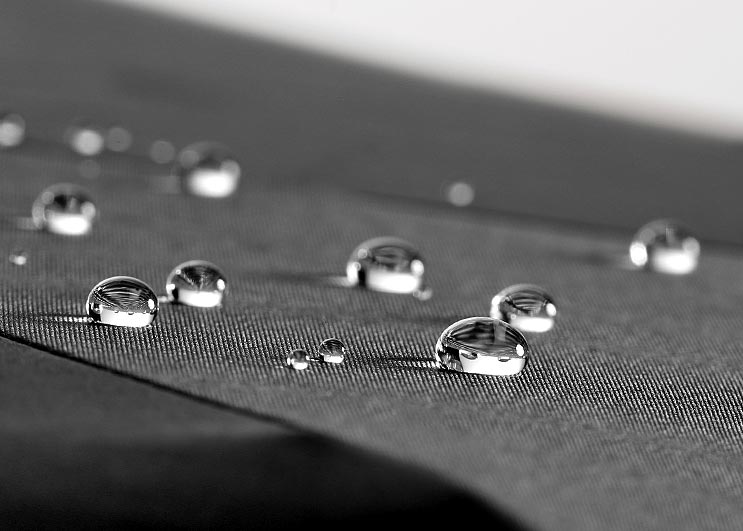ご連絡ください
お問い合わせいただきありがとうございます。ご要望について詳しく telください。専門チームが24時間以内にご返答いたします。
ご連絡ください
お問い合わせいただきありがとうございます。ご要望について詳しく telください。専門チームが24時間以内にご返答いたします。

防水生地は、撥水透湿生地と防水透湿生地の2種類に分けられます。コーティングされた生地は、水滴が表面に浸透しにくく、表面に水滴を残しますが、真の防水性はありません。どんなに撥水力の高い透湿生地でも、洗濯や長期間の使用により、最終的にはその効果は失われます。一方、防水透湿生地は、生地の裏面にゴム底が施されています。コーティングタイプとラミネートタイプに分けられ、ほとんどの防水透湿生地はラミネート加工を施しており、真の防水性を実現しています。一般的に、撥水性も備えた防水透湿生地は、撥水加工のみ、または防水透湿加工のみの生地よりも防水性に優れています。.

2.1 しっかりとした防水
マイクロファイバー断熱綿は、防水生地の初期の代表例です。英国で開発されたベンタイル生地は、最も初期の防水透湿生地です。高密度で低撚のエジプト産長繊維綿糸を使用しています。乾燥状態では、経糸と緯糸の隙間は約10ミクロンです。生地が濡れると綿糸が膨張し、経糸と緯糸の隙間は3~4ミクロンまで縮小します。この独立気泡構造と撥水加工を組み合わせることで、防水性を実現しています。現在、このタイプの生地は他の防水透湿生地に取って代わられています。.
2.2 コーティング防水
防水剤は、乾式コーティング、転写コーティング、フォームコーティングなどの方法で繊維表面に塗布され、布地表面の毛穴を密閉することで防水性を実現します。コーティング材料によって、ポリウレタンコーティング、セミポリウレタンコーティング、PVCコーティングに分けられます。.
2.3 防水仕上げ
樹脂系添加剤を繊維に塗布することで、生地の表面張力を変化させます。水滴は生地の表面でビーズ状になり、浸透したり広がったりすることなく滑り落ち、防水性を実現します。例えば、防水オックスフォード生地は優れた防水性を備えており、バッグやテントなどによく使用されています。.
2.4 フィルム接着防水
防水フィルムと他の素材の生地はラミネート加工によって接合されています。防水フィルムの保護により、複合生地の表面が濡れても内層は乾いた状態を保ちます。.

防水膜は、その機能の違いから、微多孔性親水膜、微多孔性膜、緻密性親水膜の3種類に分類されます。後者2種類の膜はより一般的です。近年、新たに開発された防水膜により、通気性と着用時の快適性が大幅に向上しています。.
3.1 微多孔性親水性膜
親水フィルムと微多孔フィルムを融合させることで、微多孔親水膜が形成されます。日本の東レは、2種類のポリウレタン材料を融合させた新しいタイプのポリウレタン材料、エントラントGIIと呼ばれる微多孔親水膜を開発しました。マイクロポアと超マイクロポアを持つポリウレタンの内層は、蓄熱機能を有し、加熱時には熱を吸収し、冷却時には熱を放出します。アメリカの研究所の研究者、ヴィゴ氏とフロスト氏は、ポリエチレングリコールを複合させた布地が蓄熱性を持つことを結論付けました。ポリエチレングリコールを含むポリウレタンコーティング布地では、重合度とポリエチレングリコールの含有量を調整することでガラス転移温度を制御し、人が快適に感じる温度範囲に保つことができます。周囲温度がポリマーの臨界温度を超えると、ポリマーは相転移を起こし、熱を吸収して体積膨張するため、通気性が向上し、涼しく快適な着心地が得られます。一方、周囲温度がポリマーの臨界温度を下回ると、ポリエチレングリコールセグメントが結晶化し、ポリマーが熱を放出するため、通気性が低下し、断熱性が向上します。.
3.2 微多孔膜
ポリテトラフルオロエチレン(PTFE)フィルムは、微多孔膜の代表的な素材です。フィルムの孔径は雨水と水蒸気の中間程度で、優れた防水性を発揮します。ゴア社が開発したゴアテックスは、PTFEフィルムと布地をラミネート加工した世界初の防水布地です。しかし、初代ゴアテックスは耐久性に課題がありました。耐久性を向上させるため、他の親水性フィルムを特殊処理し、布地とラミネート加工しました。しかし、PTFE素材は埋め立てや焼却により過フッ素化合物を生成し、大気や土壌を汚染する恐れがあります。近年、環境分野でのPTFE素材の使用に対する監視が厳しくなり、一部の国では使用制限が始まっています。.
3.3 高密度親水性膜
熱可塑性ポリウレタンフィルムは、高密度の親水性膜の一種です。気孔がなく、優れた防水性を発揮します。親水性でありながら、衣服の内外の蒸気圧差により、蒸気が高圧から低圧へ移動することで優れた通気性を発揮します。.